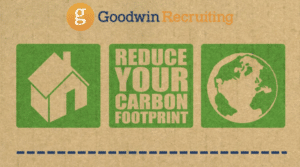Your Carbon Footprint and 20 Ways to Make It Smaller
Goodwin Recruiting | Career Tips, Manufacturing & Engineering | July 28, 2022

Imagine if your own footprint weighed 32,000 pounds. That’s 16 tons! Astonishingly, that is the average carbon footprint per person, per year in the United States. It represents the collective amount of greenhouse gas (GHG) emissions, such as carbon dioxide, methane, nitrous oxide, etc., that we are responsible for releasing into the atmosphere in our daily lives.
The U.S. Environmental Protection Agency (EPA) confirms that human activities are responsible for nearly all increases in greenhouse gases in the atmosphere over the last 150 years. Combined with industry emissions and those that naturally occur in our environments, the result is changing the global climate.
How do greenhouse gases manifest out in the world?
If you can, imagine how a 2° Celsius increase in temperature would impact our lives and the world. It might sound insignificant, but it’s not, and a growing number of earth’s inhabitants don’t even have to imagine. Sea levels are rising. Extreme weather is more common. The earth’s ecosystems are being damaged. And in some areas, risks and harm to human, plant, and animal life are already catastrophic.
MIT says that while both 1.5° and 2° Celsius are used as frameworks for defining today’s emissions goals, the pace of international climate action has put the world in jeopardy of exceeding either of those targets.
“The question is collectively, will our strategies to reduce emissions reduce them sufficiently? And so far, the answer is no,” says Maria Ivanova, an associate professor of Global Governance at the University of Massachusetts Boston.
MIT, Ivanova, and countless organizations globally are focused on scientific, government, and industry actions to curb climate change.
But what about us? Are we going to watch and wait – or help fix it?
What are we doing that’s trapping heat and warming our planet?
Individual emissions vary widely based on where we live, our habits, and our lifestyles, but pretty much everyone is a contributor. There is the oil and fuel that our cars burn, and the oil, gas, and electricity it takes to heat and cool our homes, as well as cook, do laundry, entertain, and so many other activities. And there is the food we buy, the plastics involved, the water we consume (and waste), and so much more.
In the United States, according to the EPA, the largest sources of greenhouse gas emissions come from humans burning fossil fuels directly and indirectly in the following ways.
- Transportation – 27%: This sector generates the largest share of emissions (27% in 2020), primarily from burning fossil fuels for cars and trucks and ships, trains, and planes when we use them. More than 90% of this fuel is petroleum-based for gasoline and diesel fuel.
- Electricity – 25%: Electricity production comes in second (25% in 2020). About 60% of our electricity comes from burning coal and natural gas to light, heat, and cool homes, businesses, and other facilities.
- Industry – 24%: We create demand! Things we buy that are produced from raw materials require burning fossil fuels for energy to create them. Greenhouse gas emissions are also generated from chemical reactions during the production and manufacturing process.
- Commercial and Residential – 13%: Greenhouse gas emissions from businesses and homes arise primarily from fossil fuels burned to heat buildings and homes, as well as from using products containing greenhouse gases and the handling of waste.
- Agriculture – 11%: Emissions from agriculture come from livestock such as cows, as well as from agricultural soils and the production of rice.
- Land Use and Forestry – 13%: Land acts as either a ‘sink’ (absorbing carbon dioxide from the atmosphere) or as a source of greenhouse gas emissions.
20 ways to create a smaller carbon footprint
Eventually, we all learn that big things are achieved by tackling one piece at a time. And, so it is in reducing our individual carbon footprints. While industries work to reduce GHG emissions associated with transportation, electricity, agriculture, and many other sectors, we can do our part to encourage their initiatives and our own.
Here is a starter list of 20 actions we can take, some big and some small, to help reduce greenhouse gas emissions in our own lives. The big takeaway? Less is more!
- Buy local and seasonal products instead of out-of-season products that require transport.
- Change your diet: Limit meat consumption, especially beef (start with Meatless Mondays!).
- Eat more plant-based foods.
- Select fish sourced through sustainable fishing practices.
- Reduce dairy consumption.
- Switch to reusable shopping bags.
- Refuse single-use plastic and avoid products packaged in excessive plastic.
- Buy only what you need to avoid waste.
- Insulate your home.
- Choose renewable/clean/green energy: Buy energy-efficient appliances, units, and lighting.
- Use less water!
- Turn off the lights.
- Reduce, reuse, or recycle items where possible.
- Rethink your modes and frequency of transportation.
- Ride a bicycle to work and leisure activities.
- Switch to providers that offer electricity from solar, wind, and hydroelectric energy, or consider installing your own solar panels.
- Break up with your bank if they fund the fossil fuel industry.
- Meet virtually instead of traveling to meeting places.
- Explore buying from environmentally friendly companies that invest in carbon offsets.
- Drive less and explore job opportunities where you can work from home.
Curious what your carbon footprint is?
Many people don’t give greenhouse gas emissions (and our huge contributions) a single thought. We hope this article changes that and inspires your interest. Since it’s hard to improve anything without a benchmark, you can find out the size of your current footprint free of charge.
Whether you’re just curious or serious about acting, there are many apps and websites available to feed your curiosity or help you find solutions. The Nature Conservancy provides an easy online Carbon Footprint Calculator, and the EPA’s Household Carbon Footprint Calculator is also an excellent resource to gauge your annual greenhouse gas emissions.
Ready to make a difference? Start working from home!
If number 20 on the above list caught your eye, you’re in the right place to explore it. Contact us at Goodwin Recruiting to discover remote jobs across many industries. Opportunities are plentiful, including with us as an independent Recruiting Partner or with many of our clients. Working remotely substantially reduces fuel consumption and GHG emissions – and it’s a great and rewarding fit for talented and driven professionals.
Share This Article







































